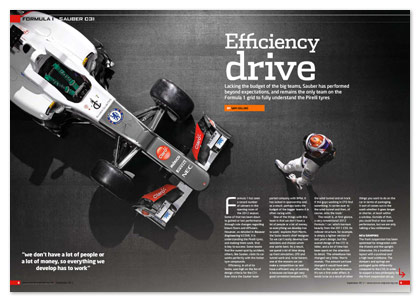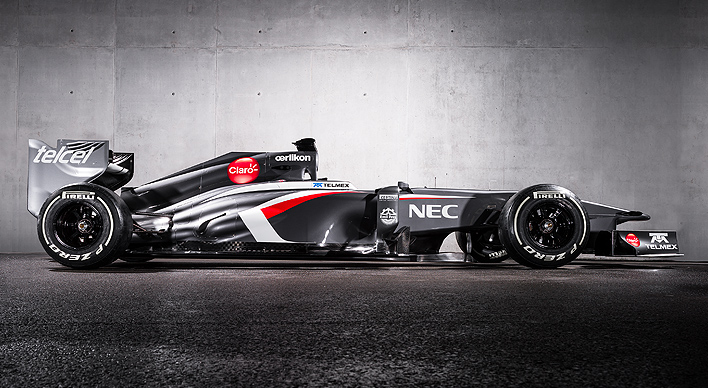
The F1 technical regulations have barely changed going into the 2013 season and yet the new Sauber C32-Ferrari is a very different proposition visually from its predecessor – thanks to a smooth, slightly downward-sloping nose section and, principally, much slimmer sidepods.
“The C31 was an extremely competitive car with many strengths,” explained Matt Morris, the Sauber F1 Team’s Chief Designer. Our aim was to further improve these strengths and eliminate its few weaknesses.
“Over the course of last season we invested a lot of time and energy in developing a better understanding of our car. To this end, we focused primarily on the aerodynamic effects around the rear of the car. Our aero experts have done some great work in this respect, the basis of which has been used to develop the C32.”
Radical changes have also been conspicuous by their absence when it comes to tyres. “We had the opportunity to test with the new generation of tyres at the last race of the 2012 season at Interlagos,” said Morris. “Although there are some differences in the construction of the tyres, as a whole the changes are minimal, which means there was no need for a fundamental redevelopment in this area.”
A year ago almost all the cars on the grid had one particular feature in common: a stepped nose. This design element caused an outcry among many fans, but was rendered nigh-on unavoidable by the regulations. For 2013, the FIA has now allowed a cosmetic fairing to be used in this area, while retaining the current chassis and structural nose height regulations.
The nose now sweeps down smoothly towards the track, which not only improves the car’s looks, but, more significantly, enhances the aerodynamics of the front end.
With the front wing, the aerodynamicists have put their faith in a proven formula, further optimising last year’s development and thus improving its aerodynamic efficiency.
The engineers also remained true to the basic concept of the front suspension, carrying out only minor adjustments.
The sidepods of the C32 are notably slimmer than the Formula One norm up to now and are responsible for giving the new car a very distinctive look. “The airflow in this area has a major influence over everything that happens at the rear of the car,” said Morris, offering a glimpse into the team’s thinking.
The significantly reduced volume of the sidepods over conventional variants makes packaging a particular challenge. Even the smallest empty space has been used to accommodate the countless components.
An extremely slim rear end was high up the engineers’ list of priorities. One of the key aspects here is the arrangement of the radiators, which is very different from that in the C31. A look at the rear end of the new car reveals the engineers’ rigorous approach to this area.
Morris said: “It is one thing the aerodynamicists coming up with great ideas, but they are often difficult to make into reality. In this respect, the design and production team has done a fantastic job on the side pods, both from a structural and packaging perspective.”
The aerodynamicists have also invested a lot of time developing the details around the exhaust exits – an area which has a major impact on performance and in which the Sauber F1 Team was one of the leading exponents last season.
As before, the car’s KERS (Kinetic Energy Recovery System), engine and gearbox are supplied by Ferrari. The KERS is based on last year’s version, but its weight and packaging volume have been optimised.
The rear axle is a totally new development. Although it still works according to the pullrod principle, its layout has been designed to better interact with the airflow around the rear of the car, while further improving the tyre management.
There is also potential for improvement in how the tyres are used in qualifying, as Morris explained: “Our car looked after its tyres very well during races last year. However, we had problems now and again when it came to getting the maximum out of them in qualifying. We’ve looked at this phenomenon closely and made the required adjustments.”
Double DRS systems are banned in this year’s technical regulations and the sporting regulations now stipulate that, during qualifying, DRS can only be activated in those areas of the circuit where it is permitted during the race. The demands placed on the aerodynamic efficiency and rear wing design, are therefore slightly different now. “We expect this to be an area where we see various developments introduced over the course of the season,” said Morris.
Another high priority was reducing the car’s overall component weight, to allow a better distribution of the ballast, while retaining its structural requirements and mechanical setup flexibility. “My colleagues have done an excellent job here, and we have even exceeded our original targets”, praised Morris.
Like last year, the Sauber F1 Team will use a basic version of the car for its rollout event and introduce a major update before the first race of the season.
“We have set ourselves lofty goals with the Sauber C32-Ferrari, and I’m confident that we’ll be able to meet them. The C31 gave us a very good basis, to which we’ve made further improvements. Our aim is to line up for 2013 with a car that is competitive from the first race, but which also offers extensive potential for further development,” summed up Morris.
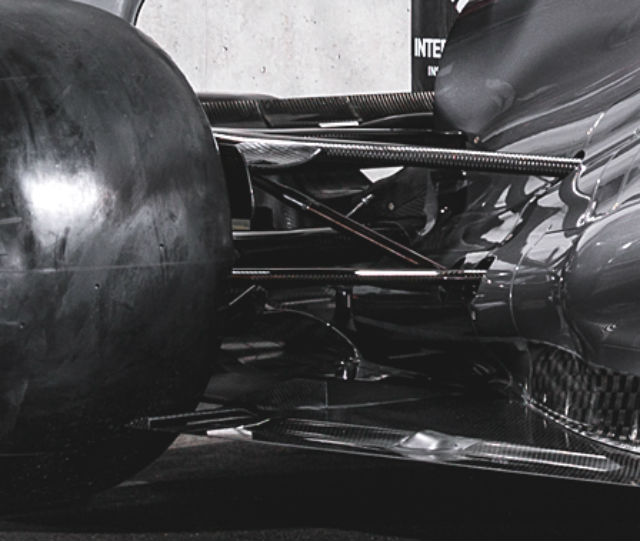
The revised rear suspension still features the Ferrari transmission and pull rod suspension (above). The exhaust exit is conventional for a 2013 car but the panel around the exit suggests that there will be rapid developments in this area still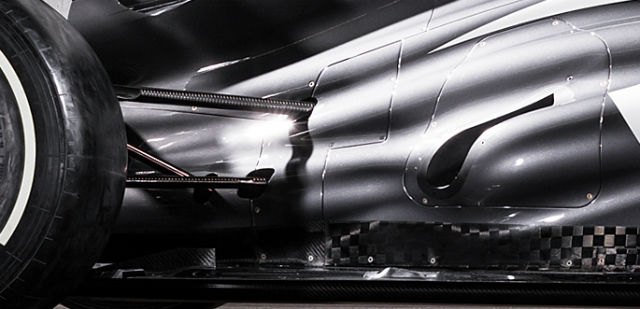
The nose of the C32 is very interesting, Sauber has not fully adopted the ‘vanity panel’ leaving the hump in the nose visible from certain angles but not in profile. The hump is shielded by two ridges running along the nose (below).
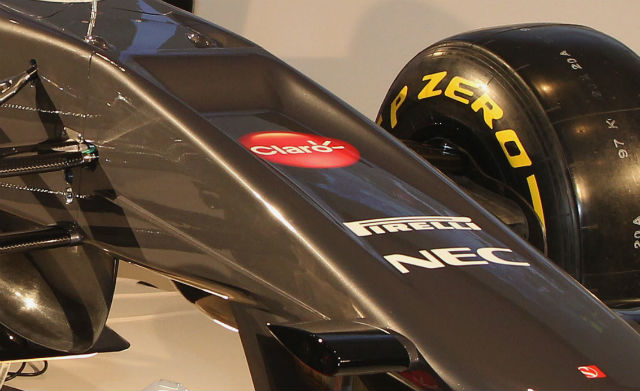
Behind the up there is a duct facing towards the cockpit, similar to the one found on the C31. The bodywork ahead of the cockpit drops down with the side of the chassis ensuring legality.
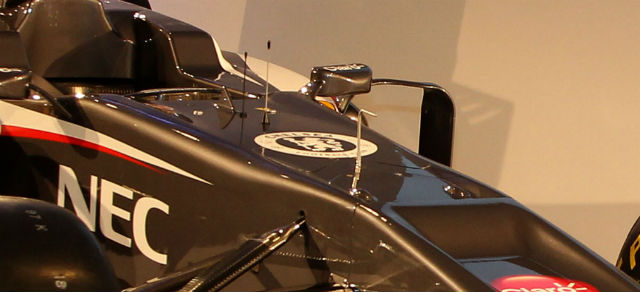
On the small sidepods Sauber has dropped its full size pod wings in favour of a solution quite similar to that of the Red Bull RB8, interestingly Lotus has gone down the route Sauber took in 2012.
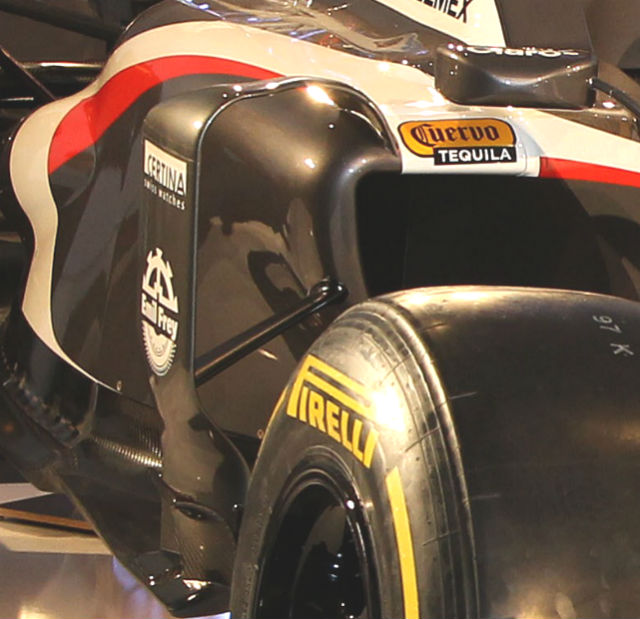
The roll hoop has changed, likely in an attempt to reduce weight, the C31 had a heavily Force India inspired roll hoop with multiple supports but as is the case with the Silverstone team the concept has been dropped in favour of having just two exposed supports.
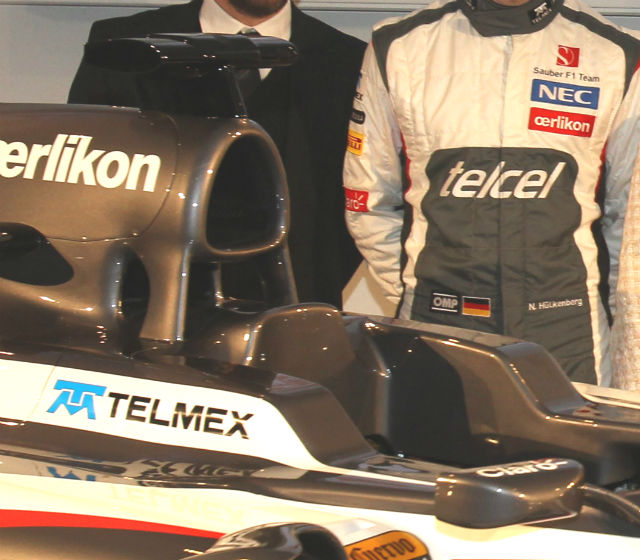
TEST 01: JEREZ
Chassis: C32-2
More detailed elements of the C32 became apparent in Jerez after the Swiss car had its first runs.
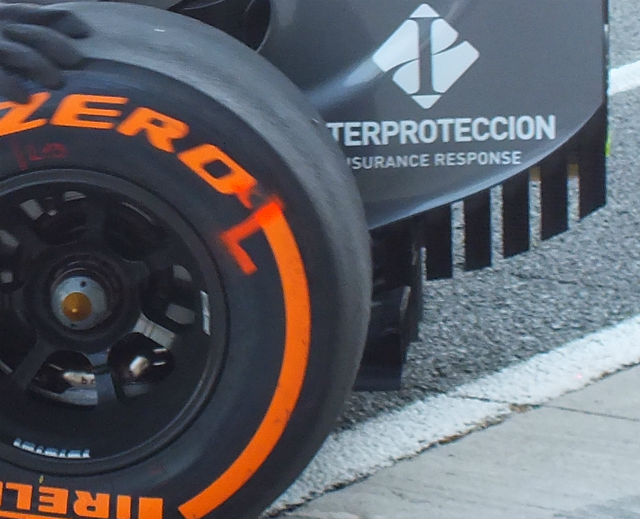
The rear wing endplate has a serrated lower section as is now common in F1. Note the rear brake (Brembo) caliper mounting position low on the wheel.
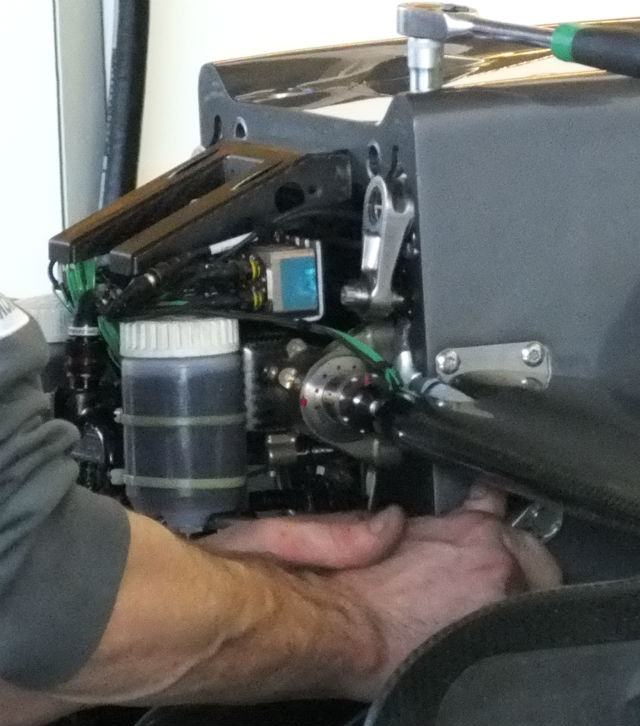
The front bulkhead of the C32 is fairly conventional also, but note the shape of the top section designed to house the cars nose duct. The torsion bars (or at least the holes they sit in) are just visible.
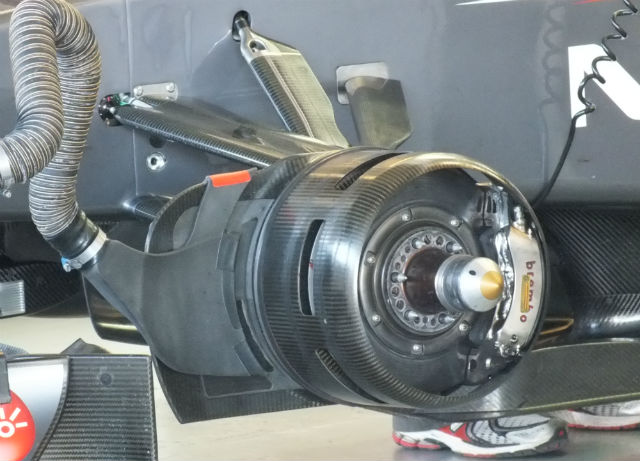
A look at the front brake layout shows the caliper mounting position with the disc and pad both visible. Note the cooling slats in the cake tim brake shroud. The unit running forward from the brake duct is a mechanics leaf blower, used to cool the discs after a run.
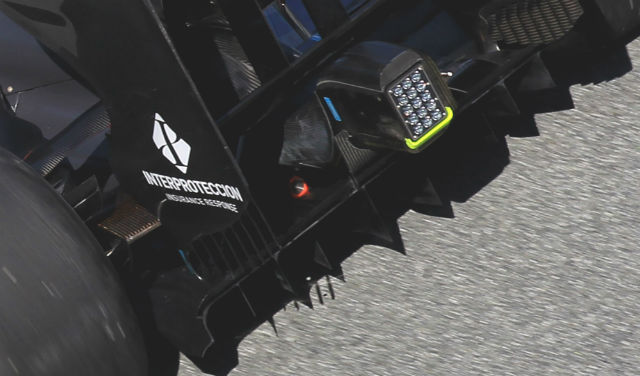
A first look at the diffuser on the C32, with the serrated lower portions of the rear wing end plates in evidence.

The above pic gives a good look at the Sauber’s nose duct.
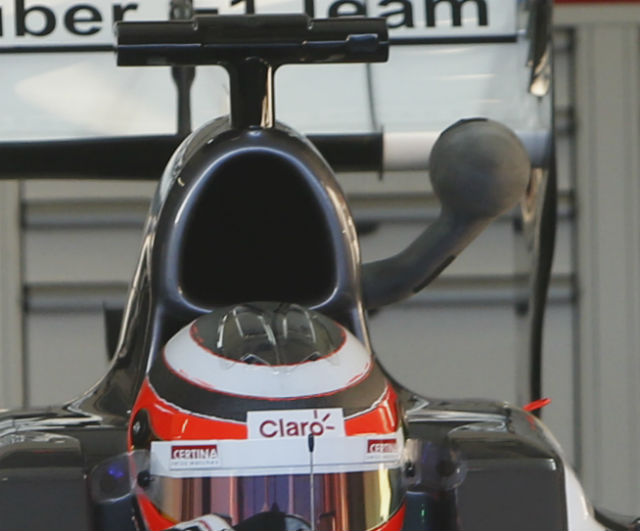
Sauber did a one lap run with this sensor mounted on the roll hoop, it has not been run on the car since.
TEST 2: BARCELONA
Chassis: C32-2

Sauber experimented with a rear wing stalling device at Barcelona, the car was fitted with Lotus style roll hoop ear ducts. These will work with a fluidic switch somewhere under the bodywork to stall the rear wing, as there is no Mercedes stye centre pillar on the wing it suggest that the C32 stalls the beam wing rather than the upper elements. Red Bull has taken a similar approach. Note the reappearance of the ‘parrot perch’ sensor.
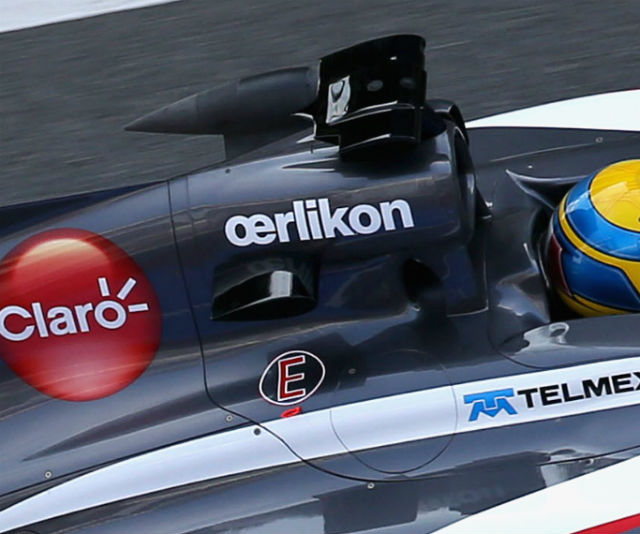
A look at the shape of the ‘parrot perch’ shows that it is similar to a F3 air box.

At Barcelona there is a particular section of track that allows photographers to capture the rake angle a particular car is running at. Compare the Red Bull RB9 (above), with the Sauber C32 (below).
 Finally take a look at the Williams FW35 with almost no rake at all (below)
Finally take a look at the Williams FW35 with almost no rake at all (below)

Sauber ran a new rear wing in Barcelona, the main plane has a very curved centre section which is lower in the centre. This is part of the teams fluidic switch concept but it appears to be a functional wing when the switch is not in use.
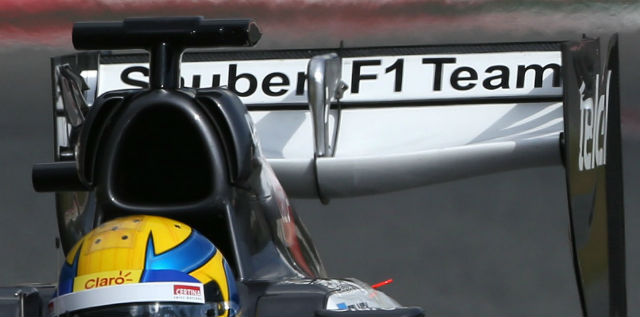
Compare with the wing used in Jerez (below) which has a much straighter main section.
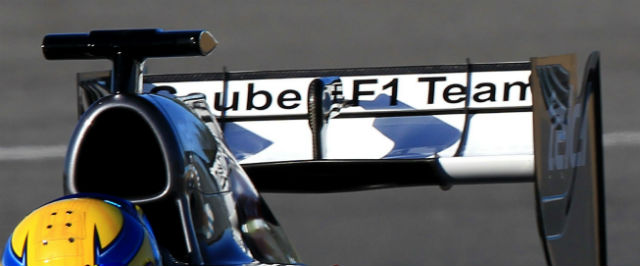 A nice look at the steering wheel of the C32 configured for its Mexican driver.
A nice look at the steering wheel of the C32 configured for its Mexican driver.
 The C32 features a bulge under its nose, the shape of the underside of a cars nose is far more important in aerodynamic terms than the upper side.
The C32 features a bulge under its nose, the shape of the underside of a cars nose is far more important in aerodynamic terms than the upper side.
 A nice look at the underside of the C32, note the shape of the front splitter, also the Brembo brakes.
A nice look at the underside of the C32, note the shape of the front splitter, also the Brembo brakes.
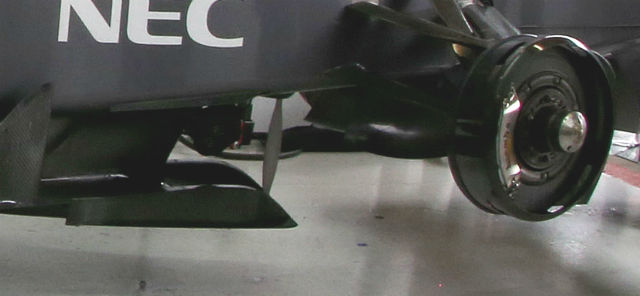 Looking at the C32’s rear floor from above reveals that it has a slightly unusual shape, with a ridge inboard of the outer edge. The narrow side pods can also be seen in this image. Note the now common place ‘hole that is not a hole’ ahead of the rear wheel.
Looking at the C32’s rear floor from above reveals that it has a slightly unusual shape, with a ridge inboard of the outer edge. The narrow side pods can also be seen in this image. Note the now common place ‘hole that is not a hole’ ahead of the rear wheel.
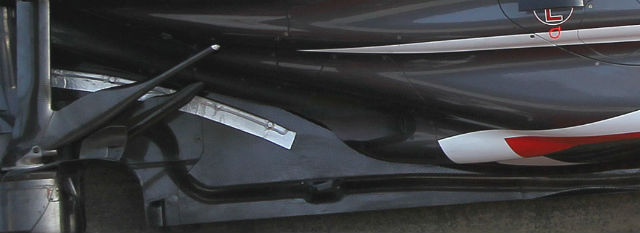 From another angle you can see how the hole links to the floors outer edge, also note the turning vane inboard next to (and possibly held on by) the silver aero tape. The small pod houses on the outer edge of the floor houses a tyre temperature monitoring system. The shape of the C32’s exhaust channel seems to have change with a more angular base.
From another angle you can see how the hole links to the floors outer edge, also note the turning vane inboard next to (and possibly held on by) the silver aero tape. The small pod houses on the outer edge of the floor houses a tyre temperature monitoring system. The shape of the C32’s exhaust channel seems to have change with a more angular base.
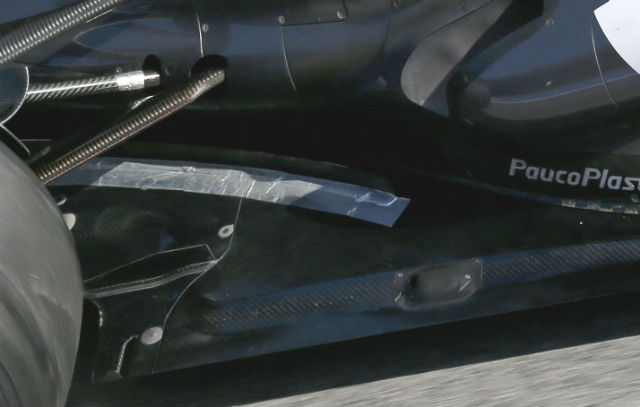 The exhaust seems to have scorched the cars bodywork on longer runs. A problem on a number of other cars and probably a result of the C32’s tight bodywork.
The exhaust seems to have scorched the cars bodywork on longer runs. A problem on a number of other cars and probably a result of the C32’s tight bodywork.
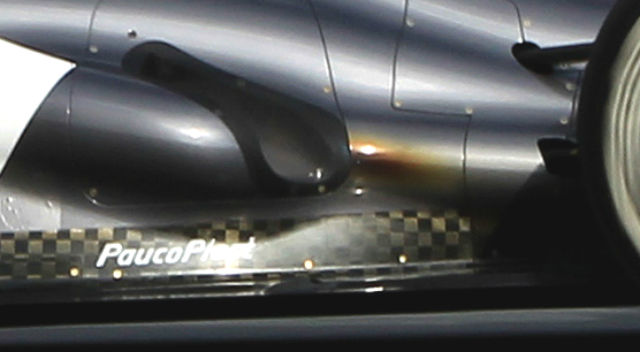 A good look at the brake housing of the C32, note the drilling pattern in the Brembo discs. Teams tend to change these according to driver and circuit demands.
A good look at the brake housing of the C32, note the drilling pattern in the Brembo discs. Teams tend to change these according to driver and circuit demands.
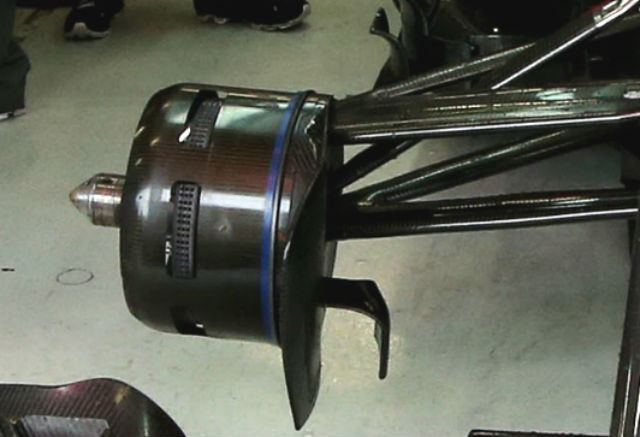 The C32 wing stalling device can be seen here, air enters the roll hoop ears and is blown onto the underside of the rear wing, stalling it and reducing drag. However this only happens at certain speeds.
The C32 wing stalling device can be seen here, air enters the roll hoop ears and is blown onto the underside of the rear wing, stalling it and reducing drag. However this only happens at certain speeds.
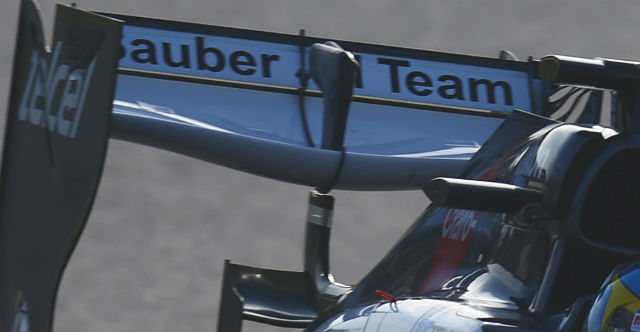 A nice look at the complex rear diffuser on the C32.
A nice look at the complex rear diffuser on the C32.
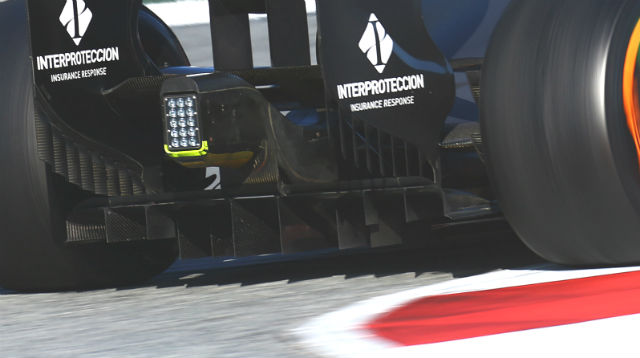
TEST 3: BARCELONA
Chassis: C32-2
RACE 01: ALBERT PARK, MELBOURNE, AUSTRALIA
Car: 11
Chassis: 02
Result:
Car: 12
Result: 13th
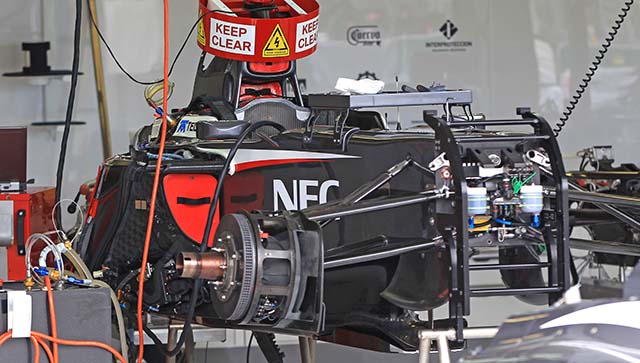
“Clearly disappointing that Nico was not able to start his first race for the Sauber F1 Team, due to a fuel system problem which didn’t allow us to make the grid. For Esteban starting from 18th was always going to be difficult, but he drove a good race, managed the tyres well and worked well with the engineers, which was positive. We will regroup now and make sure we will get the maximum out of the car in one week’s time in Malaysia.”
RACE 02: SEPANG, SELANGOR, MALAYSIA
Car: 11
Chassis: 01
Result: 8th
Car: 12
Chassis: 03
Result: 12th
“Both drivers handled the difficult intermediate condions at the beginning of the race well, and communicated well with the engineers on the pit wall to get the right tyres at the right time. It’s good to get the first points on the board. We’ve got a lot of good data to analyse, which will help us to be even stronger in Shanghai.”
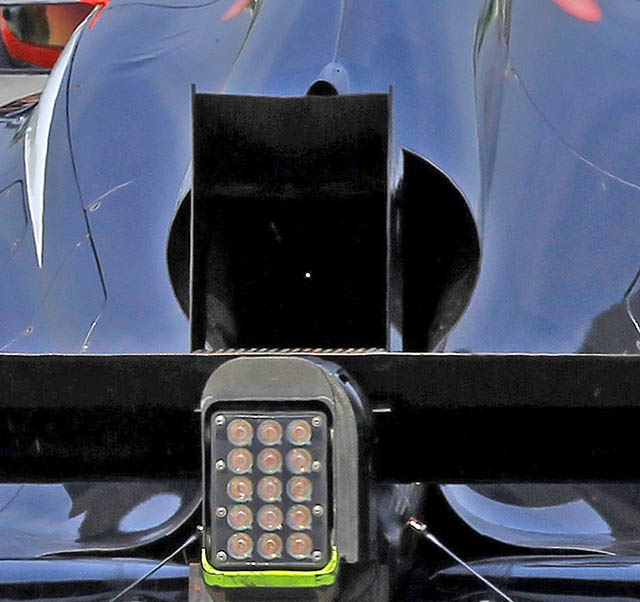
Sauber tried out a couple of different engine covers at Sepang, a new oval Red Bull style one (above) and one similar to those seen in testing and at Melbourne (below)

RACE 03: JIADING, SHANGHAI, CHINA
Car: 11
Chassis: 01
Result: 10th
Car: 12
Chassis: 03
Result: DNF (daydreaming driver?)
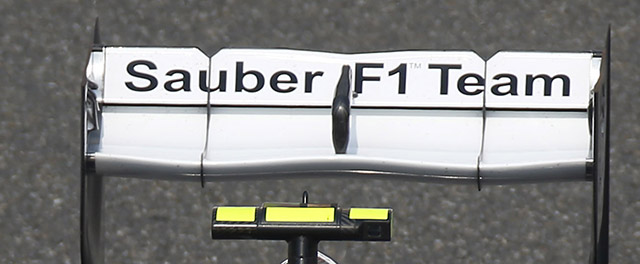
Sauber brought a new rear wing to China. Compare the new wing (above) with the old (below). The old wing was used in the race.
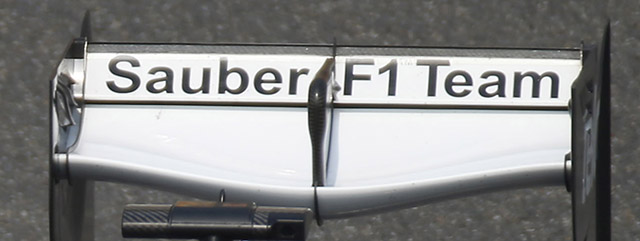
RACE 04: SAKHIR, BAHRAIN
Car: 11
Chassis: 01
Result: 12th
Car: 12
Chassis: 03
Result: 18th
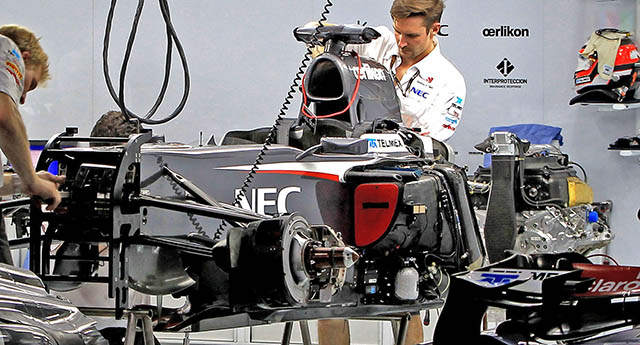
A look at the C32 getting prepared at Sakhir revealing the sidepod detail (note the square radiator) and the Ferrari 056 engine.
RACE 05: MONTMELO, CATALUNYA, SPAIN
Car: 11
Chassis: 01
Result: 15th
Car: 12
Chassis: 03
Result: 11th
Tom McCullough, Head of Track Engineering:
“Both drivers had a strong start to the race. Unfortunately with Nico the incident in the pits cost him the chance of a good result. Esteban drove a very strong race and worked well with the engineers to get the most out of the car. Although he started from 19th, he missed tenth place by less than half a second. Our race pace was stronger today than in previous races, so we can take comfort from that, and we can look forward to the race in Monaco.”
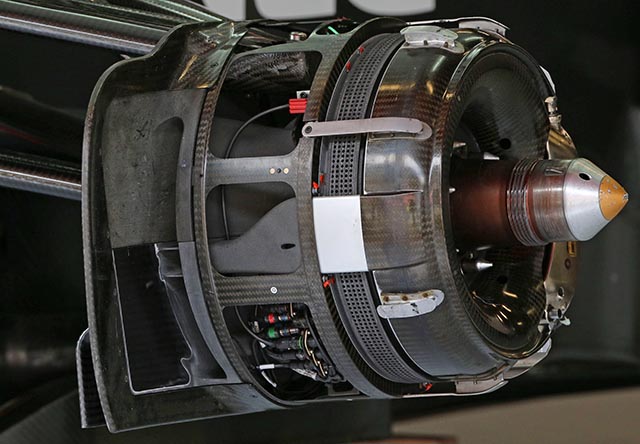
A look at the Saubers front brake setup complete with the cooling layout. The disc has a pattern of five small drillings across its width for cooling. The Brembo calliper is mounted at the rear of the disc.
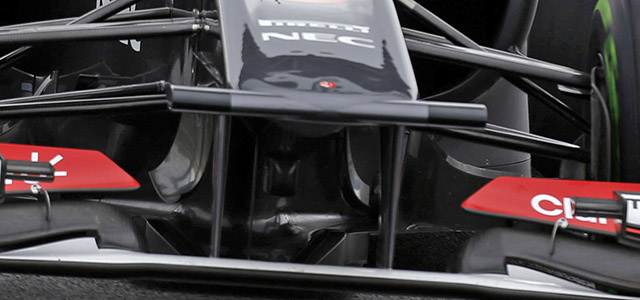
The C32 sported a new nose at Barcelona, with the mandatory front camera housings relocated to the tip of the nose, similar to the approach taken by Red Bull.

Sauber also ran with a new rear wing in Spain
RACE 06: LA CONDAMINE, MONTE CARLO, MONACO
Car: 11
Chassis: 01
Result: 11th
Car: 12
Chassis: 03
Result: 13th
Monisha Kaltenborn, Team Principal: “We are disappointed with the result today, because we were in a position to score points. The first safety car period compromised our strategy. But the most surprising thing for us was that we couldn’t gain an advantage with our choice of tyres for the re-start. Although Nico was on soft tyres – the harder compound – the degradation was higher than that of our competitors, who were on super softs. Both drivers drove well, but the car simply wasn’t good enough on this track. We still believe, however, the measures we took will show an improvement again in the next race.”
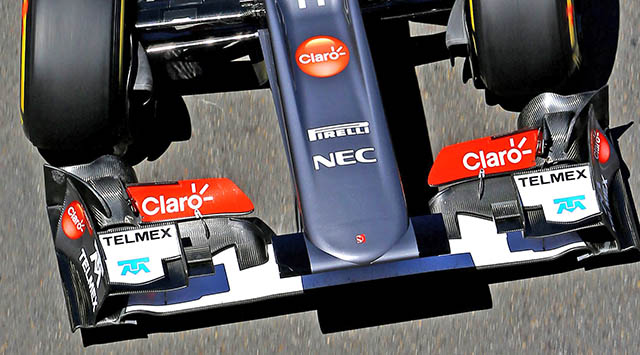
Sauber ran with two different camera positions on the nose of the C32 at Monaco (above and below).
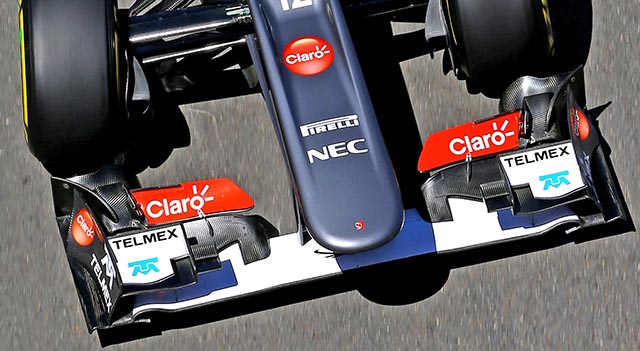
The regulations force all cars to run two identical camera housings at the front of the car but the position of them is free. Often the housings are dummys rather than fully functional units. The regulations forcing teams to run the housings was introduced after the teams running TV cameras were using the positioning of them for aerodynamic gain, and an unfair advantage. However a number of team technical directors have confirmed that the positioning of the housings can still produce small gains at the front of the car.
Sauber has released two very interesting CFD based videos based on real data from the C32. The first deals with ‘slosh’ in the fuel tank going through the Ascari Chicane at Monza, whilst the other deals with a spinning car.
Sauber changed the lap trigger receiver on the data system after a problem on track on the one car before the race whilst it also changed parts on the other including the main shaft speed sensor, a nut in the rear suspension securing the track rod, the left exhaust thermocouple as well as the lap trigger. It also changed a diffuser strake.
RACE 06: ILE NOTRE DAME, MONTREAL, CANADA
Car: 11
Chassis: 01
Result: DNF (Cut tyre)
Car: 12
Chassis: 03
Result: DNF (Driver error)
Tom McCullough, Head of Track Engineering:
“The circuit’s characteristics were going to make it a hard day for our car. Ultimately it was a double DNF, which is very disappointing. On the strategy side we attempted a one stop with Esteban and a two stop with Nico, which was the base strategy today. But ultimately the tyre degradation and wear were too high for Esteban, so we had to convert to a two stopper late in the race and unfortunately he had the incident exiting the pits. Looking forward to Silverstone, that’s a track that should suit us better. We have to make sure to get the maximum out of our car.”
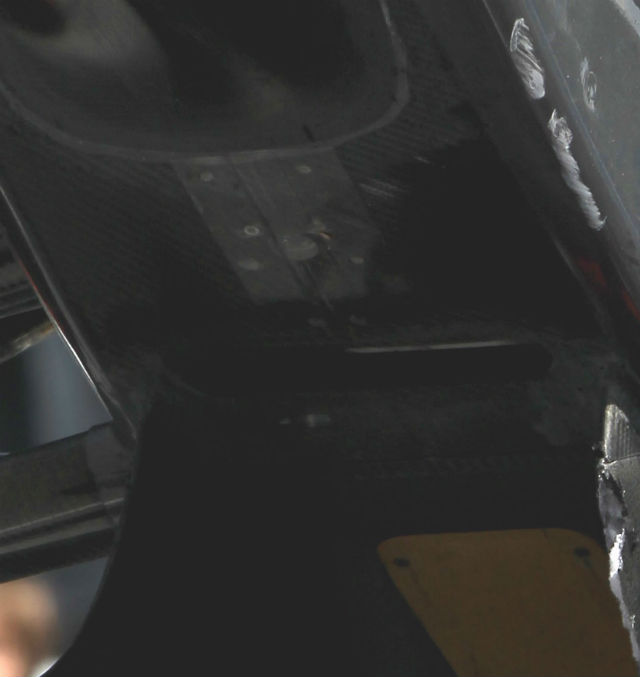
A nice look at the underside of the C32 nose clearly showing the intake duct which feeds the outlet on the top of the nose structure.
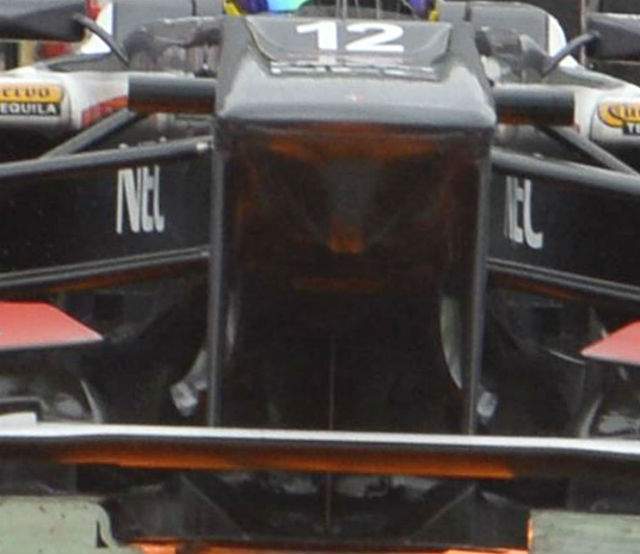
Under the nose the C32 has grown a ‘pelican’ bulge.
RACE 07: LUFFIELD PRIORY, NORTHAMPTONSHIRE, ENGLAND
Car: 11
Chassis: 03
Result: 10th
Car: 12
Chassis: 04
Result: 14th
Tom McCullough, Head of Track Engineering:
“This must have been one oft the busiest days at the pit wall for quite some time. We had a slow puncture on Nico’s car and a left front tyre problem on Esteban’s car, and both those resulted in the strategy being compromised. Esteban had to pit again two laps later, because his front wing had been damaged previously. However, from a very difficult situation Nico was able to get into P10, which gave us a very useful point.”
RACE 08: NURBURG, EIFEL, GERMANY
Car: 11
Chassis: 03
Result: 10th
Car: 12
Chassis: 04
Result: 14th
Monisha Kaltenborn, Team Principal:
“One point is not exactly what we expected after a strong qualifying, but the safety car period didn’t play into our hands. Nevertheless, we move on to the test in Silverstone and to the next Grand Prix with confidence. We were able to improve, particularly in qualifying, and we want to continue to improve. Nico delivered a strong performance. The last stint particularly was absolutely thrilling. Of course, we are not where we want to be, but we made a step in the right direction.”
TEST 04: LUFFIELD PRIORY, NORTHAMPTONSHIRE, ENGLAND
Tom McCullough, Head of Track Engineering:
“It is always exciting being associated with a driver’s first day in a Formula One car, as it is a very special day for him. Kimiya’s mature approach to the day impressed us all, as he worked well with the Engineers, improving throughout the day. This also allowed us to complete some further aero testing, which was valuable to us as a team. Our three-day test plan was very ambitious. We managed to get through the programme and are happy with all the data we have gathered on both the new aero package and the 2012 construction tyres. We feel well prepared for the Budapest race.”
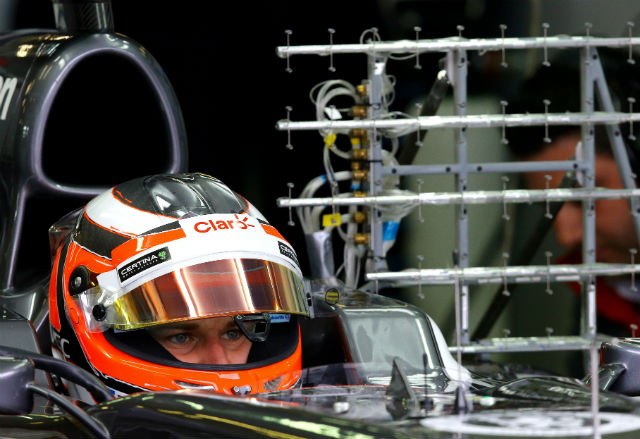
At the Silverstone young driver test the C32 was fitted with a very large sensor array, this was being used to understand the airflow around the central section of the car in the wake of the front wheel.
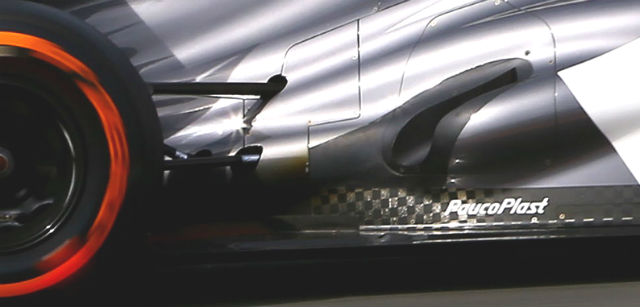
A new exhaust was tested at Silverstone, complete with a Red Bull style tunnel under the tail pipe channel. Compare the old version (above) with the new (below), also note the scorching on the new design.
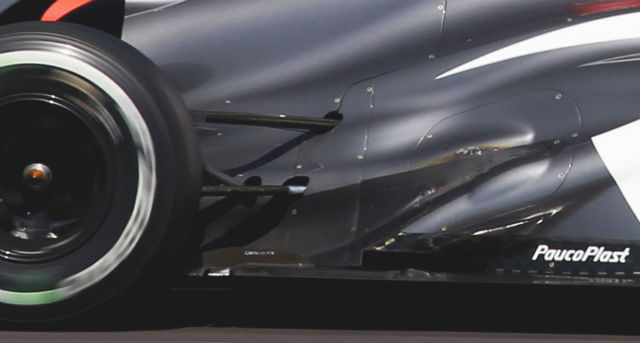
A Lotus style rear wing stalling device was also tested at Silverstone. Note the ‘ears’ on the rollhoop.
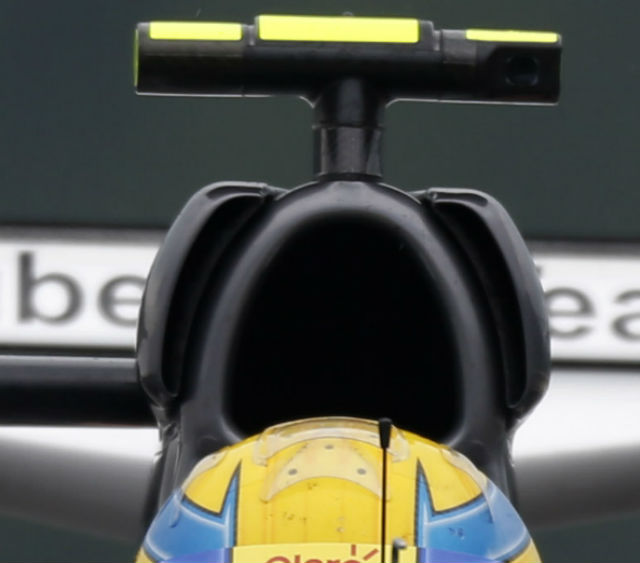
RACE 09: MOGYORÓD, PEST, HUNGARY
Car: 11
Chassis: 03
Result: 11th
Car: 12
Chassis: 04
Result: DNF (Gearbox)
Tom McCullough, Head of Track Engineering:
“Starting from P12 and P17 on this kind of circuit always makes it a hard race. Unfortunately, Nico also lost positions on the first lap, having had a good start initially. He ended up P15 at the end of the first lap. With Esteban’s car we had a gearbox problem, which we need to investigate. Unfortunately when exiting the pit lane, Nico had a problem with the activation of the pit limiter, resulting in a drive through penalty, therefore ruining any chance of points today. Going forward, we can take positives from the better tyre management and pace we showed today. We’ll return after the summer break more competitive than we started the season.”
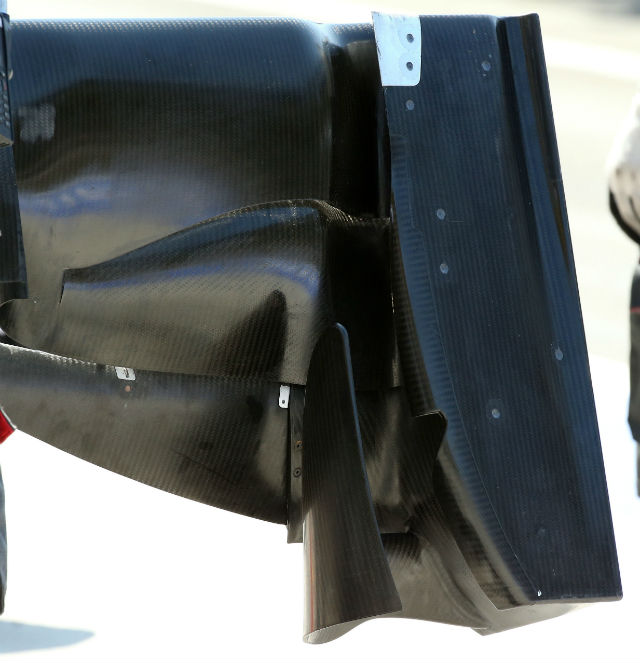
A nice look at the underside of the C32’s front wing.
SUMMER BREAK
RACE 10: FRANCORCHAMPS, ARDENNES, BELGIUM
Car: 11
Chassis: –
Result: –
Car: 12
Chassis: –
Result: –
Read more in the September 2012 issue of Racecar Engineering 